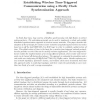8 search results - page 1 / 2 » Toward Clock Skew based Wireless Sensor Node Services |
WICON
2010
13 years 2 months ago
2010
Clock skew is defined as the rate of deviation of a device clock from the true time. The frequency of a device's clock actually depends on its environment, such as the tempera...
GLOBECOM
2008
IEEE
13 years 5 months ago
2008
IEEE
EWSN
2006
Springer
14 years 4 months ago
2006
Springer
Time synchronization is a crucial component of a large class of sensor network applications, traditionally implemented as a standalone middleware service that provides a virtual gl...
WISES
2008
13 years 6 months ago
2008
In South-East Asia, huge swarms of fireflies synchronously emit light flashes to attract mating partners. The underlying principle can be used to implement a robust and scalable d...
MDM
2009
Springer
13 years 11 months ago
2009
Springer
Location monitoring systems are used to detect human activities and provide monitoring services, e.g., aggregate queries. In this paper, we consider an aggregate location monitori...

